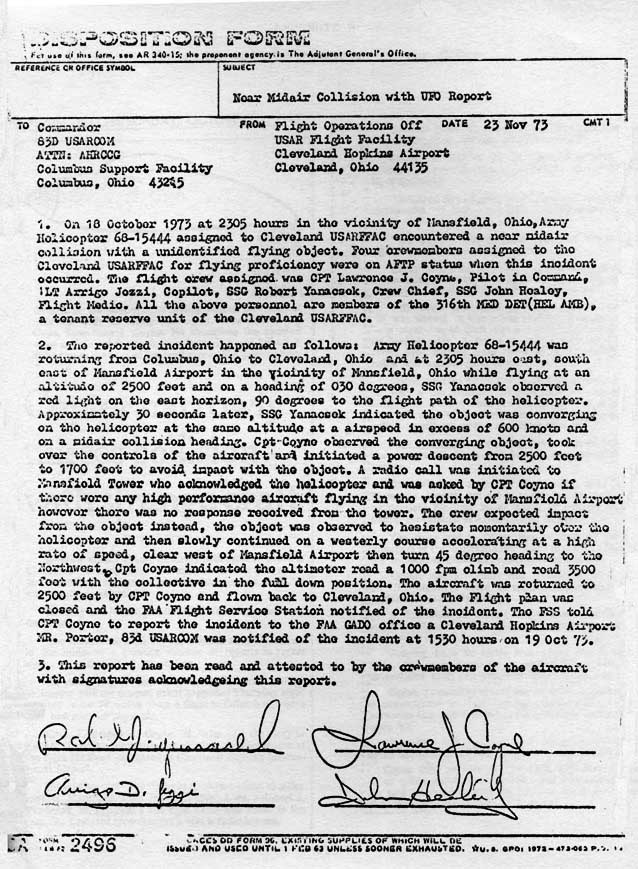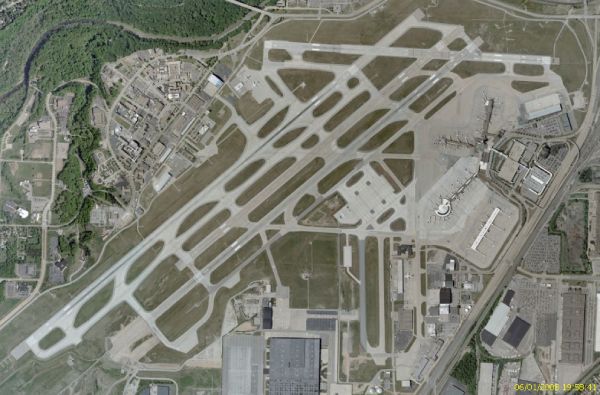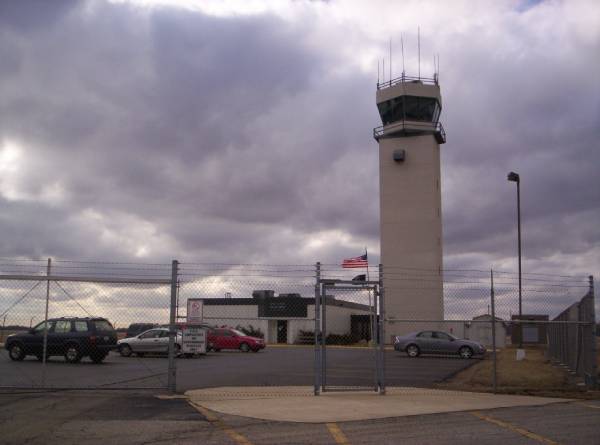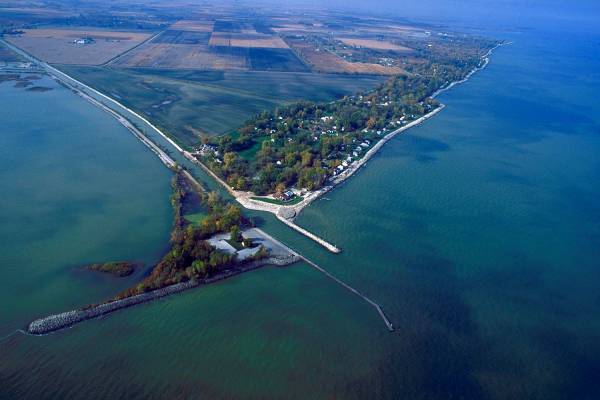Noar Midair Crash with UFO Report, Ohio
Ohio (USA), October 18, 1973
This event occurred in October 1973 with a Bell UH-1H helicopter of the US Army Reserve Aviation, which was flying with 4 crew members from Columbus to Cleveland, both in Ohio, was the object of attention of a UFO, which first headed towards the helicopter at high speed, causing the crew to fear for their lives, then, having reached the collision limit, stopped to "scan" the helicopter Helicopter with a bright green light; then the object slowly took off again, and then accelerated very quickly.
When near the object, a helicopter broke radio contact, and when the object was removed, the commander noticed that the compass scale was rotating at a speed of about four revolutions per minute, and that the helicopter was climbing more than 1,000 feet, and that even with a fully descending team (regulator regulating vertical movement), it continued to gain altitude at a vertical rate of 1,000 feet per minute.
This last fact, together with the slight jolt felt by the crew as the object began to move away, suggests that the object "hooked" the helicopter at a distance.

1. On October 18, 1973, at 2305 in the vicinity of Mansfield, Ohio, an Army helicopter 68-15444, assigned to the Advanced Air Reserve Command (USARFFAC) in Cleveland, almost flew with an unidentified flying object. . The four crew members assigned to Cleveland's USARFFAC for flight training were in the Advanced Training Period (AFTP) when the accident occurred. The crew consisted of Captain Lawrence J. Smith. Coyne, commander of the first ship. Arrigo Jezzi, Co-pilot, Serg. Robert Janacek, Crew Chief, Serg. John Healy, doctor. All of the aforementioned employees are members of the 316th Medical Detachment (Eliambulanze), the USARFFAC support unit in Cleveland.
2. The incident in question occurred as follows: Army helicopter 68-15444 was returning from Columbus, Ohio, to Cleveland, Ohio, when at 2305 (East Coast time) it was southeast of Mansfield Airport, near the city of the same name. , at an altitude of 2,500 feet on a course of 030 degrees, Sgt. Janacek noticed a red light on the eastern horizon at a 90-degree angle to the helicopter's course. After about 30 seconds, Serg. Janacek warned that the object is moving towards the helicopter at a speed of more than 600 mph at the same altitude and on opposite courses. Observing the approaching object, Captain Coyne took control of the aircraft and began a controlled descent from an altitude of 2,500 to 1,700 feet to avoid colliding with the object.
Captain Coyne radioed Mansfield Tower and, after the tower acknowledged the call, asked if there was a high performance aircraft flying nearby, but there was no response from the tower. As the crew assessed the impending impact, the object was seen hovering over the helicopter for a moment, then moving slowly west, and then, upon finding itself in an area west of Mansfield Airport, rapidly accelerating and then turning 45 degrees to the northwest. Captain Coyne noted that the altimeter indicated an altitude of 3,500 feet and that the helicopter was gaining altitude at a rate of 1,000 feet per minute when the crew was in a fully lowered position. Captain Coyne returned the aircraft to an altitude of 2,500 feet and dispatched it to Cleveland, Ohio.
The flight plan was closed and the incident was reported to the local Flight Service office of the Federal Air Force Administration (FAA), which recommended that Captain Coyne report the incident to the FAA Civil Aviation Administration at Cleveland Hopkins Airport. The incident was reported to Mr. Porter
3. This report has been read, verified, and signed for acceptance by the crew members.
ffree statement of the report
Incident Analysis by Jenny Zeidman
Coyne's UFO case (or "Army Helicopter Plane Crash") stands out as probably the most likely (in the "high oddity" category) wave of 1973.
While flying between Columbus and Cleveland, Ohio. (USA) An Army reserve helicopter crew consisting of four people came across a cigar-shaped object of gray and metallic color, which had unusual lights and performed equally unusual maneuvers. The crew received a $ 5,000 Blue Ribbon award from the NATIONAL ENQUIRER for "The Highest Scientific Report of 1973."
On the night of October 18, 1973, at approximately 22:30, a U.S. Army Reserve UH-1H helicopter took off from Port Columbus, Ohio, to return to its base at Cleveland Hopkins Airport, 96 nautical miles away in a north-northeast direction. In the front right-hand seat, Captain Lawrence J. Smith was in command. Coyne, thirty-six, with nineteen years of flying experience. First Lieutenant Arrigo Gezzi, a twenty-six-year-old chemical engineer, sat at the wheel in the front left seat. Behind Jezzie was Sergeant John Healy, thirty-five, a Cleveland police officer who was the ship's doctor, and behind Coin was the crew commander, Sergeant Robert Janacek, twenty-three, a computer technician.
The helicopter was flying at an altitude of 2. At an altitude of 500 feet above sea level at the specified speed of ninety knots over hilly terrain mixed with hills, forests, and cultivated areas, the average altitude of which was about 1,200 feet. The night was very clear, calm, and starry. The moon was in its last quarter rising above the horizon.

About ten miles south of Mansfield, Healy spotted a single red light flying south. It seemed brighter than the usual light on the left-wing of the plane, but since it didn't seem like a movement worth noticing, he doesn't remember mentioning it. About a couple of minutes later, when it was about 23:02, Janacek noticed a red light on the southeastern horizon. He thought it might be a telecommunications tower beacon or a light from the left-wing of an airplane - most likely an airplane, since it wasn't flashing - and continued to watch it for "a long time, from one minute to ninety seconds" before notifying Coin. Coin, who was smoking in a relaxed manner at the time, leaned over to look.
About thirty seconds later, Janacek announced that the light had changed direction and was moving toward the helicopter on a converging course. After verifying Janacek's claim, Coyne took Jezzi's command and put the UH-1H on a controlled descent at about 500 feet per minute. Almost simultaneously, Coyne established radio contact with the Mansfield control tower, ten miles to the northwest. Coyne actually thought it might be an F-100 Air National Guard plane from Mansfield. After the tower initially responded with a confirmation call ("Mansfield Tower is here, ahead of Army 1-5-3-4») radio contact was interrupted. Jezzi then tried to re-establish communication on both the VHF and UHF bands, but to no avail. There were the usual background noises usually made by radio, but no response came from Mansfield. Coyne's subsequent check revealed that even the first call was not recorded on Mansfield's tape and that the last F-100 landed at 22:47.

The red light continued on its way, greatly amplifying. Coyne increased the descent rate to 2,000 feet per minute and the airspeed to 100 known. The last altitude he noticed was 1,700 feet. As soon as a collision was imminent, the unknown light stopped moving westward and assumed a hovering position above and in front of the helicopter.
He didn't move anymore, he stopped. For ten, maybe twenty seconds, it just stopped
Janacek said.
Coyne, Healy, and Janacek agreed that the cigar-shaped object with a small dome has an angle almost equal to the width of the windshield. A gray structure with a metallic appearance, with no special characteristics, it stood out clearly against the starry sky. Janacek reported that he had a "window impression" at the top of the dome. The red light came from the bow, and the white light became visible in a small recess in the structure, then a green "pyramid" beam, comparable to a searchlight beam, became visible from the lower aft part. As it moved upward, the green beam passed to illuminate the nose of the helicopter, then the windshield and continued upward through the transparent colored roof panels. It was at this moment (and not before) that the cabin was flooded with a green light.
Jezzi reported only bright white light, comparable to the front light of a small plane, which is visible through the upper windshield panels. After about ten seconds of steady flight, the object began to accelerate to the west, and now only the white "tail" light was visible. The light kept its intensity constant, even when the distance to the object seemed to increase.
The object then (according to Coyne and Healy) appeared to make a sharp 45-degree turn to the right, heading toward Lake Erie, and then "splashed" out onto the horizon. Healy said he watched the object move westward for "a couple of minutes." Jezzi said it was traveling at more than 250 knots, which is the limit for planes below 10,000 feet, but not at the 600 knots it approached, as reported by others. During the collision, there was no sound or turbulence from the object, except for a small "push" when the object began to drift to the west.

After the object completed its flight at a fixed point with the helicopter, Jezzi and Coyne noticed that the magnetic compass disk was rotating at about four revolutions per minute and that the plane was gaining speed at 1,000 feet per minute. Coyne insisted that the collective is still in the fully lowered position in which he adjusted it for an evasive descent.
Unable to lower it any further, he had no choice but to raise it, whatever the consequences, and after a few seconds of frantic command operation (during which the helicopter reached almost 3,800 feet), he regained control of the plane. By then, the white light had already reached the Mansfield area. Coin was aware of the ascent on a subconscious level, but not others who were well aware of the consequences of the descent. The helicopter was returned to an altitude of 2,500 feet in accordance with the flight plan, radio communication was established with Canton / Akron, and the flight continued without further action.
Events up to Cleveland
Ground-based witnesses to the event were identified by William E. Jones and Warren Nicholson, independent UFO researchers from Columbus, Ohio.
At approximately 23:00 on October 18, 1973, Ms. E. K. and four teenagers were driving in their car from Mansfield to their country home when their attention was attracted by one bright, steady red light flying "At medium altitude". They watched him for about a minute until he disappeared into the trees to the south. About five minutes later, on Highway 430 heading east near the Charles Mill Reservoir, the family noticed two bright lights-red and green-rapidly descending toward them from the southeast. At first, the angular distance between the two lights was about 2 degrees, with the red one appearing to precede the other.
Mrs. C. She stopped at the edge of the deserted road, her engine and headlights still on. The lights - more intense than the point source-slowed down and moved as a single body along the right side of the car, and the family noticed another group of lights - some of them flashing-and "bang, lots of confusion" they were approaching from the southwest. Two boys (cousins, both thirteen years old) jumped out of the car and watched the helicopter and the object, which they described as "like a blimp", "the size of a school bus", " with a pear-shaped image form ". Now the object was at an angle equal to a 100-millimeter pack of cigarettes held at arm's length.
The object took a hovering position above the helicopter, about 500 feet from the road and 500 feet above the trees. (The altitude of the ground at this point is almost exactly 1,000 feet above sea level; so, given the last altitude measured on the 1,700-foot altimeter, the helicopter was about 650 feet above the trees.) Then the green light of the object lit up like a flame.
It was as if the rays were falling.
The helicopter, the trees, the road, the car-everything turned green.
It was as if the rays were falling.
The helicopter, the trees, the road, the car-everything turned green.
It was as if the rays were falling.
The helicopter, the trees, the road, the car-everything turned green.
the witnesses said
The frightened boys ran back to the car, and Mrs. K. drove away quickly. They estimated the time they didn't get out of the car to be "about a minute." Neither the witnesses on the ground nor the helicopter crew was able to determine with certainty the moment when the two planes came out of combat; Witnesses on the ground reported that the unidentified object crossed the road as it passed the car to the north, moved east for a few seconds, then changed direction and rose northwest towards Mansfield, a trajectory that completely coincides with the movement of the reconstructed object. according to the crew's testimony.
Any theory that confirms that it is a meteor (the skeptic Philip Klass claims that it was "a fireball from the Orionid group") can easily be refuted on the basis of:
1) the duration of the event (about 300 seconds);
2) net deceleration and maneuvers of the object in the phase of the greatest approach;
3) clearly defined shape of the object;
4) trajectory from horizon to horizon.
The probability that it could be a high-performance aircraft is also untenable if we examine the positions and colors of the lights in relation to the object's trajectory. To show the lights in accordance with FAA requirements, the aircraft must fly sideways, standing vertically, tail down and pointing towards the helicopter, or with its nose turned towards the helicopter.
Other arguments against the airplane hypothesis are as follows:
1) a fixed-wing aircraft moving across the observer will move faster when it passes in front of it;
2) a fixed-wing aircraft will not be able to slow down from a high speed to a fixed point in seconds;
3) the helicopter could continue to fly with a fixed point, but could not reach the high speed reported by witnesses;
4) a normal aircraft, at an altitude of 500 to 1000 feet, would create an audible noise inside the helicopter;
5) The FAA requires every aircraft to have a flashing or rotating light at the top or bottom of the fuselage;
6) The FAA requires that no aircraft flying below 10,000 feet above mean sea level exceed 250 knots;
7) at least some of the characteristics of a conventional aircraft should be visible, such as wings, engine nacelles, windows, tails, brands.
Coyne reported that when the next day
The non-destructive Magnaflux / Zygio test method was applied to the helicopter rotors to check whether they were subjected to mechanical overload, the test gave a negative result. Analysis of time, as well as distance and direction, supports the possibility that the red light is originally seen by the K family, the red light is seen by Healy, and the main character of the encounter was the same. The red light that Janacek saw on the eastern horizon, which remained under his constant control, was undoubtedly the target of the collision.
The case has retained its status of the "strangeness of credibility" even after a thorough analysis and investigation.
About author:
Serg Toporkov Ufologist, Ph.D., blogger, I go on my own expeditions for UFOs. I use scientific methods to investigate the UAP phenomenon. Write to me |
Related tags:
UFO ufo report Ohio 1973 ufo sightings ufo incident FAARandom UFO or conspiracy article
The Anatomy of the Gray Alien Roswell Hoax and gentleman from Tennessee
 In this article, we will try to figure out where the truth is and where the lie is.
In this article, we will try to figure out where the truth is and where the lie is.
